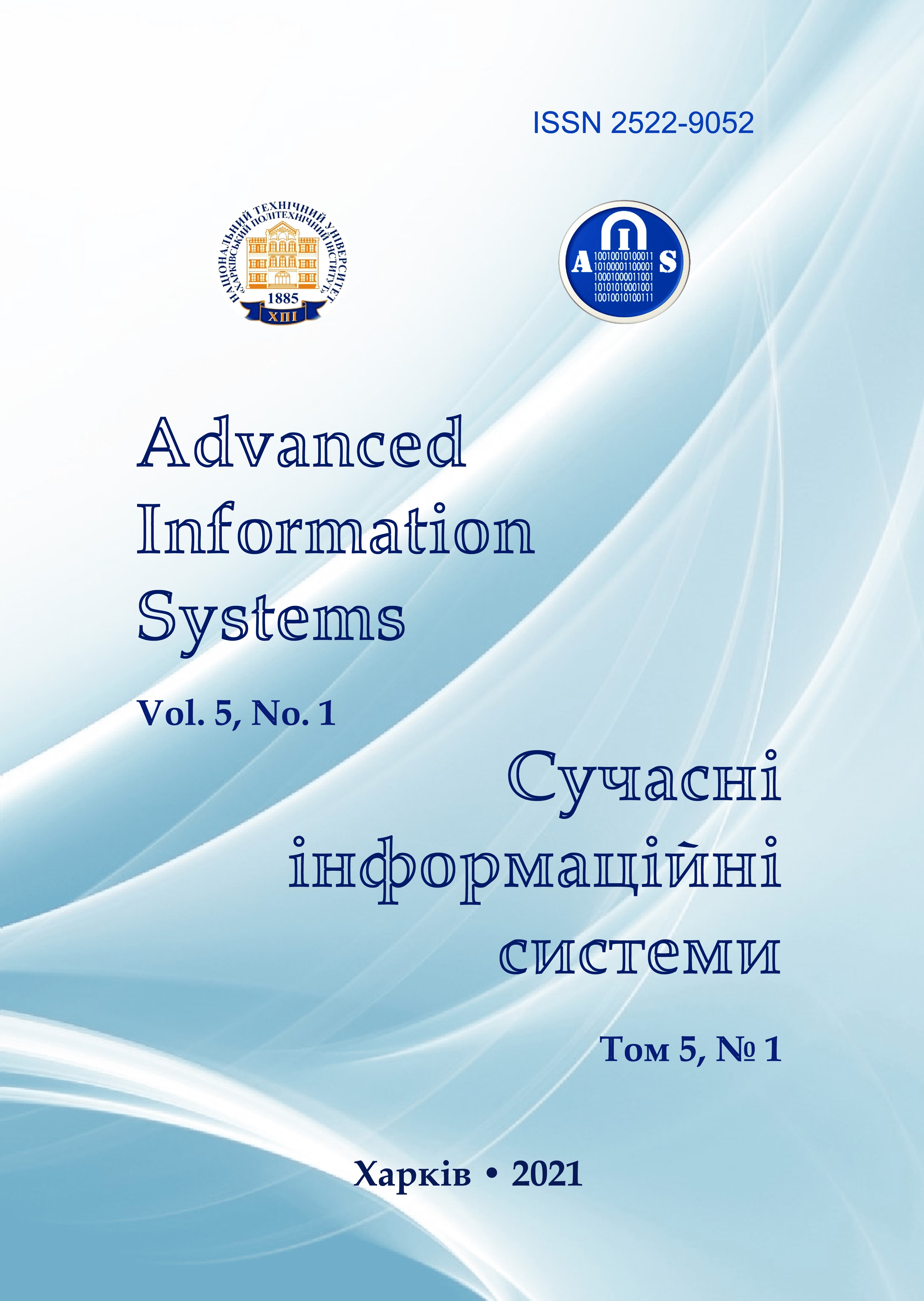METHOD OF MODELING OF A SOCIAL PROFILE USING BIG DATA STRUCTURE TRANSFORMATION OPTIMIZATION
Main Article Content
Abstract
The object of the research are methods and algorithms of optimizing of the Big Data transformation to build a social profile model, the subject of the research are methods of constructing of a social profile. For decision-making person, the problem of scientific methodological and instrumental re-equipment is relevant for the effective fulfillment of a set of managerial tasks and confronting of fundamentally new challenges and threats in society. This task is directly related to the problem of building of a model of the social profile of both the individual and the social group as a whole. Therefore, the problem of optimizing of methods of constructing of a mathematical model of a social profile is certainly relevant. During the research, methods of the mathematical apparatus of graph theory, database theory and the concept of non-relational data stores, Big Data technology, text analytics technologies, parallel data processing methods, methods of neural networks' using, methods of multimedia data analyzing were used. These methods were integrated into the general method, called the method of increasing of the efficiency of constructing of a mathematical model of a social profile. The proposed method improves the adequacy of the social profile model, which will significantly improve and simplify the functioning of information systems for decision-making based on knowledge of the social advantages of certain social groups, which will allow dynamic correction of their behavior. The obtained results of testing the method make it possible to consider it as an effective tool for obtaining of an objective information model of a social portrait of a social group. This is because the correctness of setting and solving of the problem ensured that adequate results were obtained. Unlike the existing ones, the proposed modeling method, which uses an oriented graph, allows to improve significantly the quality and adequacy of this process. Further research should be directed towards the implementation of proposed theoretical developments in real decision-making systems. This will increase the weight of automated decision-making systems for social climate analysis.
Article Details
References
Mayer-Schönberger, Viktor and Cukier, Kenneth (2013), Big Data: A Revolution that Will Transform how We Live, Work, and Think, Business & Economics, Houghton Mifflin Harcourt, 242 p.
White, T. (2015), Hadoop: The Definitive Guide, O'Reilly Media, Inc., 235 p.
Tiwari, G. (2011), NoSQL: What It Is and Why You Need it > Definition and Introduction, Professional NoSQL, Packt Publishing, 384 p.
Saravana, Balaji B., Karthikeyan, N.K. and Raj Kumar, R.S., (2018), “Fuzzy service conceptual ontology system for cloud service recommendation”, Computers & Electrical Engineering, Vol. 69, pp. 435–446, DOI: https://doi.org/10.1016/j.compeleceng.2016.09.013.
Merlac, V., Smatkov, S., Kuchuk, N. and Nechausov A. (2018), “Resourses Distribution Method of University e-learning on the Hypercovergent platform”, Сonf. Proc. of 2018 IEEE 9th International Conference on Dependable Systems, Service and Technologies. DESSERT’2018, Ukraine, Kyiv, May 24-27, pp. 136-140, DOI: http://dx.doi.org/10.1109/DESSERT.2018.8409114
Mozhaiev, M., Kuchuk, N. and Usatenko, M. (2019), “The method of jitter determining in the telecommunication network of a computer system on a special software platform”, Innovative technologies and scientific solutions for industries, Vol. 4 (10), pp. 134-140. doi: https://doi.org/10.30837/2522-9818.2019.10.134.
Kuchuk, G., Kovalenko, A., Komari, I.E., Svyrydov, A. and Kharchenko, V. (2019), “Improving big data centers energy efficiency: Traffic based model and method”, Studies in Systems, Decision and Control, vol 171, Kharchenko, V., Kondratenko, Y. (Eds.), Springer Nature Switzerland AG, pp. 161-183, DOI: http://doi.org/10.1007/978-3-030-00253-4_8
Manyika, J., Chui, M., Brown, B., Bughin, J., Dobbs, R., Roxburgh, C. and A Byers, Hung (2011), “Big data techniques and technologies”, Big data: The next frontier for innovation, competition, and productivity, McKinsey Global Institute, pp. 27-31.
Donets, V., Kuchuk, N. and Shmatkov, S. (2018), “Development of software of e-learning information system synthesis modeling process”, Advanced Information Systems, Vol. 2, No 2, pp. 117–121, DOI: https://doi.org/10.20998/2522-9052.2018.2.20.
Dhivakar, B., Saravanan, S.V., Sivaram, M. and Krishnan R.A. (2012), “Statistical Score Calculation of Information Retrieval Systems using Data Fusion Technique”, Computer Science and Engineering, Vol. 2, Issue 5, pp.43-45, doi: http://doi.org/10.5923/j.computer.20120205.01
Sivaram, M., Yuvaraj, D., Amin Salih, Mohammed, Porkodi, V. and Manikandan V. (2018), “The Real Problem Through a Selection Making an Algorithm that Minimizes the Computational Complexity”, International Journal of Engineering and Advanced Technology, Vol. 8, iss. 2, 2018, pp. 95-100.
Buslov, P. (2017), “Analysis of using the features of communication models in social groups and virtual communities”, Ukrainian Scientific Journal of Information Security, vol. 23, issue 1, pp. 39-44.
Swami, M. and Thulasiraman, K. (1984), Graphs, networks and algorithms, Mir, Moscow, 455 p.
Kovalenko, А. and Kuchuk H. (2018), “Methods for synthesis of informational and technical structures of critical application object’s control system”, Advanced Information Systems, Vol. 2, No. 1, pp. 22–27, DOI: https://doi.org/10.20998/2522-9052.2018.1.04
Kuchuk G.A., Mohammad A.S. and Kovalenko, A.A. (2011), “The parametric data transmission control method for modifying the transport protocols of wireless networks”, Information Processing Systems, No. 8 (98), pp. 211-218.
Kuchuk G.A., Mohammad A.S. and Kovalenko, A.A. (2011), “Method for reducing data transmission time in a wireless network”, Control, navigation and communication systems, No. 3 (19), pp. 209-213.
Ruban, I., Kuchuk, H. and Kovalenko A. (2017), “Redistribution of base stations load in mobile communication networks”, Innovative technologies and scientific solutions for industries, No 1 (1), P. 75–81, doi : https://doi.org/10.30837/2522-9818.2017.1.075.
Nechausov, A., Mamuziĉ, I. and Kuchuk, N. (2017), “Synthesis of the air pollution level control system on the basis of hyperconvergent infrastructures”, Advanced Information Systems, Vol. 1, No. 2, pp. 21–26, DOI:
https://doi.org/10.20998/2522-9052.2017.2.04 .
Zubov, V.S. (1999), Programmer's handbook. Basic methods of solving graph problems and sorting, IIID House "Filin". Moscow, 256 p.
Shamraev, A., Shamraeva, E., Dovbnya, A., Kovalenko, A. and Ilyunin, O. (2017), “Green microcontrollers in control systems for magnetic elements of linear electron accelerators”, Studies in Systems, Decision and Control, 74, pp. 283-305, DOI: https://doi.org/10.1007/978-3-319-44162-7_15
Ore, O. (1968), Graph theory, Nauka, Moscow, 336 p.
